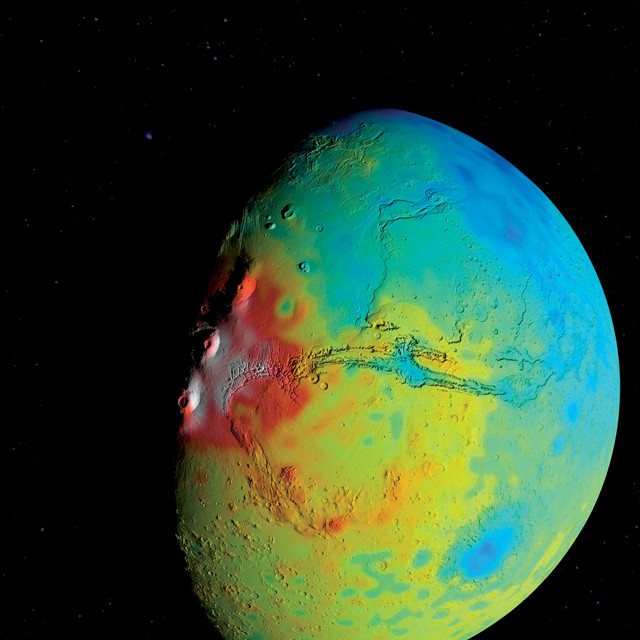
by Timothy Oleson Wednesday, November 15, 2017

NASA scientists produced a new map of Mars' crustal thickness based on a combined analysis of gravity and topographic data. The work suggests that the planet's crust is less dense on average and that variations in thickness between thicker (red) and thinner (blue) portions of crust are smaller than previously thought. Credit: NASA/Goddard/UMBC/MIT/E. Mazarico.
With two rovers patrolling the surface of Mars, six spacecraft orbiting above it, and scientists here on Earth studying the Red Planet from afar, new findings are announced often. Here are a few of the latest updates.
The first direct detection of boron on Mars offers another line of evidence for the past habitability of the planet, according to a new study in Geophysical Research Letters. Researchers analyzing data from the ChemCam instrument on NASA’s Curiosity rover found concentrations of boron in veins of groundwater-deposited calcium sulfate running through mudstone and sandstone in 3.8-billion-year-old Gale Crater. This groundwater likely leached boron from evaporite salts in the crater, the researchers noted, suggesting the water ranged from about zero to 60 degrees Celsius and had neutral to alkaline pH — hospitable conditions for microbial life as we know it. In addition to offering clues about the habitability of ancient Martian groundwater, boron could have also played a significant role in initiating life on Mars if it existed. On Earth, borates — compounds of boron and oxygen — are known to stabilize the sugar ribose, an integral part of RNA, when dissolved in water. “Borates are one possible bridge from simple organic molecules to RNA. Without RNA, you have no life. The presence of boron tells us that, if organics were present on Mars, these chemical reactions could have occurred,” said Patrick Gasda, a postdoctoral researcher at Los Alamos National Laboratory and lead author of the study, in a statement.
New research, published in Geophysical Research Letters, suggests Mars’ crust is less dense on average than previously thought. Scientists at NASA’s Goddard Space Flight Center in Maryland used satellite gravity data to estimate Mars’ crustal density and create a new map of global crustal thickness. These gravity data have been used for similar purposes previously, but the data are of low resolution compared to what’s available for Earth and the moon, and the accuracy of density estimates has been uncertain. In the new work, researchers also accounted for how Mars’ crust has been reworked over time — which changes its porosity and density — by using detailed measurements of the planet’s topography in tandem with the gravity data. “With this approach, we were able to squeeze out more information about the gravity field from the existing datasets,” said study co-author Terence Sabaka in a statement. The researchers found that Mars’ crust has a bulk density of about 2,580 kilograms per cubic meter, somewhat lower than an earlier estimate of 2,900 kilograms per cubic meter. The new results also confirmed, in agreement with past findings, that large lateral variations in crustal density exist, with volcanic complexes such as the Tharsis Plateau being significantly more dense, for example.
A new study suggests that sinuous ridges that stretch for tens of kilometers, overlapping and crosscutting one another in an area called Aeolis Dorsa — which lies along the boundary between Mars’ northern lowlands and southern highlands — resulted from a process called topographic inversion in which incised river channels become filled in with sediments, which are then cemented into rock. As weaker rock in the surrounding landscape subsequently erodes, these infilling sedimentary rocks are gradually exposed as topographically high ridges that preserve information about the paths of the original channels. Interpretation of the patterns left by the ridges and other sedimentary features suggests they formed in a paleocoastal region that was subjected to multiple episodes of falling and rising water levels, during which successive river channels were carved and filled, according to Benjamin Cardenas at the University of Texas at Austin and colleagues. Similar patterns have been observed on Earth in settings affected by gradual changes in eustatic sea level, the researchers noted in the Geological Society of America Bulletin, and the findings support the notion that Mars’ vast northern lowlands could represent a former ocean basin.
© 2008-2021. All rights reserved. Any copying, redistribution or retransmission of any of the contents of this service without the expressed written permission of the American Geosciences Institute is expressly prohibited. Click here for all copyright requests.